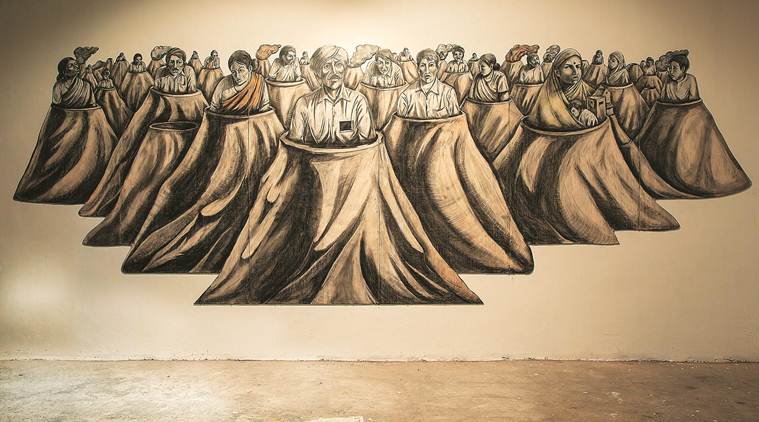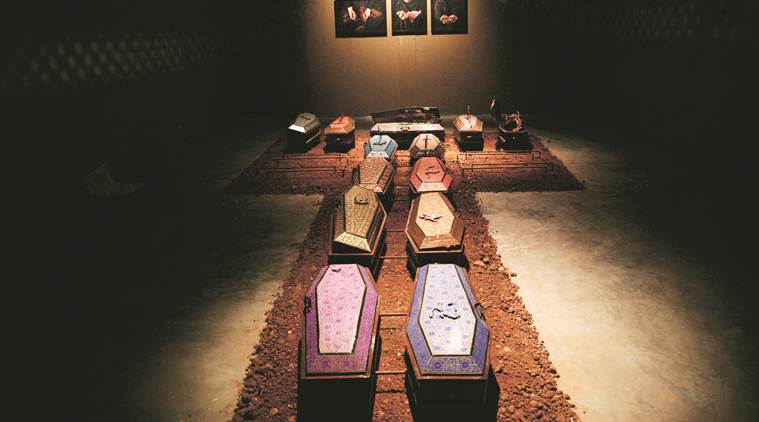Artists dwell on their experiences to bring voices from the margins to the fore at the Kochi Muziris Biennale.

Prabhakar Prachpute
There could perhaps have been no place more befitting than the Anand Warehouse for artist Prabhakar Prachpute’s Resilient Bodies in the Era of Resistance. Once a centre for trade in food grain, the walls of the storage godown hold portraits of farmers in plywood cutouts peering out of gunny bags, attempting to make their voices heard. “Farmers across India are protesting, there is resistance and aggression but no violence. It is a question of survival,” says Chandrapur-based Prachpute. He brings to the fore the apathy of the government to their crippling debts. Belonging to a family of farmers, his grandfather was forced to sell his land in Sasti village in Chandrapur, Maharashtra, for the development of coal mines. The subsequent generations have worked in coal mines, the abject conditions of which Prachpute has depicted in his previous works.

Vinu VV
Artist Vinu VV recalls being aware of his Dalit identity early on. “I knew that some others were more privileged,” says the Kochi-based artist. Some months ago, when curator Anita Dube invited him to participate in the Biennale, it was natural for Vinu to bring his concerns to the platform. His assemblage draws from the struggles of the subaltern, the rituals and the writings. The sculptures are made of (locally known) Othalam Cerbera, called the suicide tree for the poisonous fruits it yields, and often used for fencing properties in Kerala. The central installation comprises hundreds of small figurines nailed to tree trunks, referencing a ritual at the Chottanikkara temple, Ernakulam, where women believed to be possessed, drive nails onto temple walls with their foreheads to be freed. Vinu reverses patriarchy, choosing to depict men. His protagonists are the minority, migrant labour and the queer in Kerala. The human figure with a wheel is inspired by Benoy PJ’s poem First Steps: For Ayyankali, that evokes Villuvandi Samaram, the bullock cart struggle of Mahatma Ayyankali, a radical anti-caste crusader. A video plays excerpts from the works of three Malayalam novelists — Vaikom Muhammad Basheer, C Ayyappan and Pattathuvila Karunakaran. “There are several layers to the discrimination that exists,” says Vinu.
Vipin Dhanurdharan
Everyone is invited to artist Vipin Dhanurdharan’s open kitchen at Aspinwall House — you can eat, wander or even cook a meal and serve. Dhanurdharan assures no questions will be asked. “It is a place where everyone is equal. People from all communities and background can share a meal,” he says. His inspiration is social reformer Sahodaran Ayyappan’s misrabhojanam, a community dining initiative that was organised to critique the caste segregation in Cherai in 1917. In rooms overlooking his kitchen are portraits of hundreds who have let Dhanurdharan come into their homes over the last few months. As part of the project at the Biennale, Dhanurdharan would approach the residents of Fort Kochi to host him for meals. “I wanted to see how forthcoming people were to let in strangers. Some were more inviting than others,” says the self-taught, Kochi-based artist.
Srinagar Biennale
After an outing at the prestigious Art Basel in May this year, the Srinagar Biennale has travelled to Kochi. “It is not meant to be restricted to Kashmir. We want the voices to be heard across the world,” says artist Inder Salim, who conceptualised the Biennale. In Kochi, the showcase has been curated by artist Veer Munshi, and also comprises his work. “In one of the works, I recreate a shrine as a place of worship that saw different communities come together. Spaces like these have now been marginalised, so many lives have been affected. The artists represent these inclusive voices alongside the shrine. The only recourse is to give life and return love to the region,” says Munshi, who also has several baby coffins with papier-mache bones and skulls lined inside the shrine, among his other works.
The display is a means to discuss numerous concerns. If Gargi Raina has crows as messengers, in his series “If there’s a son that she could kiss”, Syed Mujtaba Rizvi juxtaposes his own images with those who have disappeared in Kashmir. “The viewer will have to search for the current status of the people in these images — just like the parents of the disappeared person are in a state of perpetual search,” writes Rizvi. In a video by Sanna Matoo, we see a gravedigger sharing his trauma, and Neeraj Bakshay’s minimalist drawings titled Premonitions gives “graphic representation of happenings unfurling in the Valley”. During their 12-hour performance in Kochi, artists Saquib Bhatt and Hina Arif, meanwhile, mock-frisked the viewers, reenacting the constant surveillance the Valley is under.
Aryakrishnan
On December 15, as artist Aryakrishnan screeched as he ran outside his exhibit space, several heads turned to see who it was in a red long dress. It was Aryakrishnan masquerading as ‘Sweet Maria’, the transgender activist who was found dead in Kollam in 2012. The Delhi-based, curator-activist dedicates his showcase at the Biennale to Sweet Maria. The room has been turned into an archival space, with portraits of Maria — a mirror for viewers to reflect on identities, and queer literature — to ponder over. During the performance that Aryakrishnan organised with friends, Gee Imaan Semmalar and Raju Rage, several questions were raised not just about Sweet Maria’s mysterious death, but also if the life for transgenders in India has changed since. Is the recent reading down of Section 377 just the beginning of a long battle ahead? “I am doing this for Maria. She would have wanted this,” said Aryakrishnan, “The work evokes unwritten history of queer lives.”



No comments:
Post a Comment